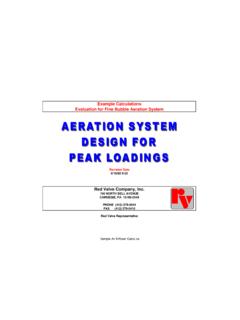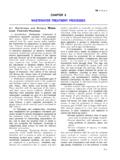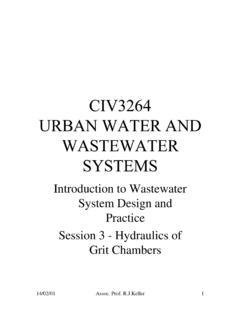Transcription of A Constant SRT Calculated From Liquid Flows Improves BNR ...
1 A Constant SRT Calculated From Liquid Flows Improves BNR activated sludge performance Stephen Greenwood, , Metropolitan Council 230 East Fifth Street St. Paul, MN. 55101 Claude Anderson, , Metropolitan Council Mike Rieth, , Metropolitan Council Ted Stein, , Metropolitan Council ABSTRACT Control of Solids Retention Time (SRT) in the activated sludge process is critical for ensuring effective wastewater treatment. SRT sets the growth rate of microorganisms in the activated sludge process, thereby selecting the microbial composition of the mixed liquor and its settling and treatment properties. The industry has developed various methods to control activated sludge .
2 This study evaluated seven (7) methods to calculate SRT and implemented a simple, straightforward hydraulic control of SRT method. The study was conducted at the 34 mgd Seneca WWTP in Eagan, MN, which operates a plug-flow nitrifying activated sludge process with reduced air- Flows in initial zones to enhance phosphorus removal. Hydraulic control of SRT is based on a solids mass balance over the aeration tanks and clarifiers. Specifically, it depends on the influent wastewater forward flow rate into the aeration tanks, the clarifier underflow rate, the waste sludge flow rate and aeration tank volume in service. It eliminates the need for costly TSS sampling at various points in the process, along with its associated measurement variation and time lags.
3 During this study, hydraulic control produced an SRT that agreed with conventional estimation methods, mass under aeration divided by mass flow rate wasted, when the conventional methods were corrected for solids inventory in the clarifiers. Hydraulic control of SRT provides a simple, real-time calculation to adjust wasting flow rates of return sludge to maintain a target SRT and a stable microbial population. At the Seneca WWTP, hydraulic control of SRT, combined with gently air-mixed inlet aeration zones, simplified process control, reduced O&M costs, and produced an excellent effluent quality that averaged mg/l TSS, mg/l BOD, mg/ l total phosphorus and mg/l ammonia.
4 Key Words: Solids Retention Time, Phosphorous removal, ammonia removal, activated sludge , BNR, SRT INTRODUCTION Solids Retention Time (SRT) control in aeration systems is a key parameter for ensuring effective wastewater treatment. This study focuses on the use of hydraulic control of Solids Retention Time to optimize process operations at the 34 mgd Seneca WWTP in Eagan, MN. The Metropolitan Council owns and operates the Seneca WWTP and provides regional wastewater treatment for the Minneapolis St. Paul area. The Seneca facility operates a plug-flow nitrifying activated sludge process and reduced airflows in initial zones to enhance phosphorus removal (Figure 1).
5 Using Liquid flow measurements alone, Seneca successfully implemented a simple, real-time algorithm for hydraulic control of activated sludge SRT, following an initial comparison of alternate SRT calculations. Solids Retention Time (SRT) sets the growth rate of microorganisms in an activated sludge process, thereby selecting the microbial composition of the mixed liquor. For consistent wastewater treatment, SRT must be controlled at a level that oxidizes pollutants, nitrifies, while providing "bugs" that flocculate and settle. When SRT is not controlled or controlled poorly, the mixed liquor contains a composite of microorganisms that are not optimized for the current growth conditions; it is also difficult to determine an SRT response to poor performance .
6 Over the years, the industry has developed various methods to make waste flow adjustments and control activated sludge SRT, including: 1) Direct SRT control using measurements of MLSS inventories and waste sludge solids flow rates (TSS concentrations and flow rates)1, 2) F:M control1, 3) Control to a Constant MLSS level in the aeration tanks1, 4) Hydraulic control of SRT2,4,5. The first three methods require TSS and BOD estimation by laboratory methods, centrifuge spins or online analyzers. Also, the definition of MLSS inventory may or may not include clarifier inventories or solids not under aeration, anaerobic zones. The use of the first three methods requires lab analysis of Suspended Solids.
7 This SRT study at Seneca evaluated the seven (7) different variations to calculate SRT. Other plant changes were made to improve the Biological Nutrient Removal (BNR) process. These changes included improved flow diversion to increase hydraulic detention time in the anaerobic zone and flow restrictions to reduce scum buildup in the anoxic zone. METHODOLOGY There are various methods to calculate the Solids Retention Time, depending upon the assumptions made1. This section describes seven (7) different SRT calculation methods evaluated. Method 1- Conventional SRT: The conventional SRT (days) is equal to the mass of MLSS in the aeration tank (lbs.)
8 Divided by the mass of solids wasted each day ( ). SRT1 = (V * MLSS * )/ WAS Equation 1 Where: V = Volume of tanks in service (mg) MLSS = Mixed Liquor Concentration (mg/l) WAS = Mass of Solids wasted ( ) = Waste Flow (gpm) * %TS * 24*60* Method 2 Modified Conventional SRTa, including the mass of final clarifier solids estimated from clarifier sludge depth measurements at an assumed MLSS concentration: The SRT is equal to both the mass of MLSS in the aeration tanks, plus the mass of solids in the final clarifiers divided by the mass of solids wasted each day. The mass of solids in the final clarifier is estimated by assuming that the solids concentration in the final clarifier is equal to the MLSS concentration, then is multiplied by the sludge blanket volume and conversion factors.
9 SRTa = ((V * MLSS * ) + M2)/ WAS Equation 2 Where: M2 = Estimated mass of solids in the final tanks = MLSS * ( sludge Depth * Area of Tank) * * /1,000,000 Method 3 Modified Conventional SRTb, including the mass of final clarifier solids estimated from clarifier sludge depth measurements at an assumed TSS concentration equal to the average of the MLSS and RAS concentrations The SRT is equal to the mass of MLSS in the aeration tank plus the mass of final clarifier solids divided by the mass of solids wasted each day. The mass of solids in the final clarifier is estimated by assuming that the solids concentration in the final clarifier is equal to the average of the MLSS and the RAS concentration, then the average concentration is multiplied by the sludge blanket volume and conversion factors.
10 SRTb = ((V * MLSS * ) + M3)/ WAS Equation 3 Where: M3 = Estimated mass of solids in the final tanks =((MLSS + RAS) / 2) * ( sludge Depth * Area of Tank) * * /1,000,000 RAS = Return activated sludge Concentrations (mg/l) sludge Depth (feet) Area of Tank (square feet) Method 4 Hydraulically determined SRT: Hydraulic controlled SRT2 is based on a simple mass balance around the aeration tanks and final clarifiers. The two equations used to calculate hydraulic controlled SRT are as follow: Clarifier Input = Clarifier Output (Q + R W) * MLSS = R * RAS Equation 4 Where: Q = Influent Forward Wastewater Flow R = Return Rate from the Clarifiers, prior to wasting W = Waste Rate MLSS = aeration tank outlet TSS concentration into the clarifiers RAS = return sludge (waste sludge ) TSS concentration out of the clarifiers Equation 4 is written for the clarifier mass balance, when the waste meter is after the return flow meter, as in the case at the Seneca WWTP.


